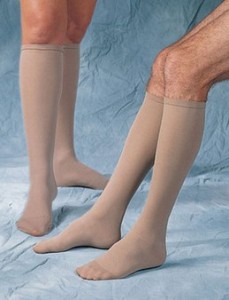
Deep Vein Thrombosis
What are deep vein thrombosis (DVT) and pulmonary embolism (PE)?
Deep vein thrombosis (DVT) means thrombosis (clotting) of blood in the deep veins of the legs. It can cause swelling and pain in the leg, but often occurs without giving any symptoms. A DVT may well
settle completely, as the thrombosis is dissolved by natural processes. If a DVT extends up the deep veins, two things can happen:
1. The thrombosis can become dislodged from the vein, and get carried through the main veins and heart to lodge in the lungs; this is called a pulmonary embolism. Small pulmonary emboli may cause chest pain, and sometimes coughing up of blood. Multiple or larger pulmonary emboli may cause breathlessness. A large pulmonary embolus which blocks the main blood vessels to the lungs can be fatal.
2. The thrombosis can cause chronic blockage in the deep veins or damage to their valves, leading to long term swelling and sometimes skin problems at the ankle.
Who is at risk of deep vein thrombosis?
We have no direct evidence about people at special risk of DVT as a result of long journeys, but based on evidence about surgical operations the following increase the risk:
- Having had a DVT or pulmonary embolism before
- Having had a recent major operation
- Pregnancy
- The contraceptive pill or hormone replacement therapy (HRT)
- Malignant disease (cancer)
- Obesity (being overweight)
- Severe heart disease
- Some blood diseases
- Varicose veins
The risks of DVT are probably highest for people with more than one of these risk factors.
How do I reduce the risk?
There is now evidence that wearing below the knee graduated compression stockings reduces the chance of DVT for people with special risk factors (listed above). Because so few people without risk
factors ever develop DVT or pulmonary embolism as a result of long journeys, there is no definite evidence about other measures which reduce the risk. However, based on what is well known about the
causes of DVT and the successful methods of prevention used in hospitals, the following are sensible precautions, particularly on long haul flights and other journeys lasting several hours:
- Move your legs: Don’t sit with your legs bent for hours on end.
- Stretch your legs out from time to time, and move your feet up and down at the ankles.
- Stand up to stretch the legs now and then. Stretching and moving your legs stops blood stagnating in the deep veins of the calf, and is the simplest and most effective thing you can do.
- Go for a walk up and down the aisle.
- Don’t get dehydrated: Drink plenty of fluid – water is ideal.
- Avoid excessive alcohol, which tends to cause dehydration.
-
-
 Compression
stockings
Compression
stockings
Wear compression stockings: Graduated compression stockings reduce the risk of DVT. They also help to prevent the ankle swelling which many people experience on long journeys. Below-knee stockings are the most comfortable kind, and seem just as effective as full length stockings. Medical graduated compression stockings are supplied in three classes: Class 1 or Class 2 stockings are suitable for most people (Class 3 are excessively strong for this purpose). Compression stockings can be prescribed by a doctor if there is a medical need. The stockings can be bought at chemists, surgical appliance specialists, and now at some other shops, for example in airports. These stockings come in a range of sizes, and your legs will need to be measured to get the right fitting. People who have trouble with the arteries of their legs should seek medical advice before using compression stockings.
-
- Aspirin: Taking an aspirin tablet (either a 75mg “junior aspirin” or a normal 300mg aspirin tablet) a few hours before a long journey may provide a small amount of extra protection against DVT.
- Anticoagulants: Special anticoagulant drugs (e.g. heparin injections, or warfarin by mouth) may be advisable for a few people who have medical conditions with a particularly high risk of DVT. This kind of treatment will always be on the explicit advice of a doctor.
REMEMBER – THE RISK OF DEEP VEIN THROMBOSIS ON LONG JOURNEYS IS VERY SMALL.
THE BEST PRECAUTION IS TO STRETCH AND MOVE YOUR LEGS REGULARLY.

